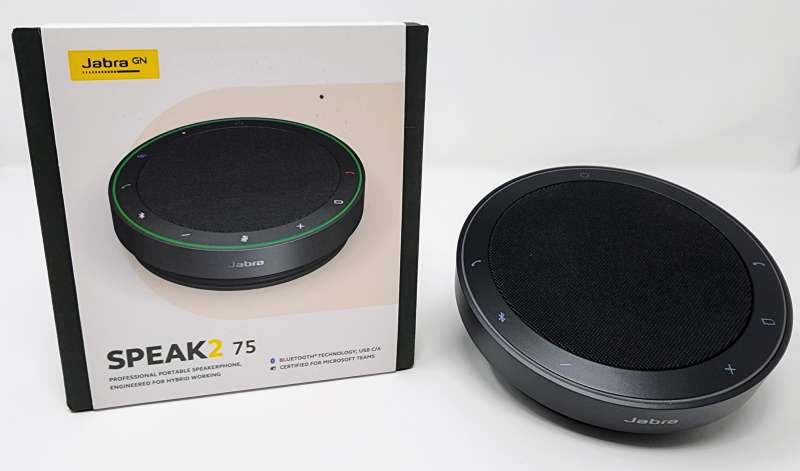
REVIEW – The bane of any office dweller’s existence is the meeting. And whether it is because of COVID or just the geo-diverse nature of today’s business, more and more we’ve come to rely on conferencing equipment to enable clear communications. The Jabra Speak2 75 is the latest in a strong lineage of speakerphones to step up and offer its services. How does it fare? Read on to find out…
What is it?
The Jabra Speak2 75 is the top-end offering in a new line of speakerphones from the Danish audio company. Designed for small to mid-sized teams, the Speak2 is optimized for softphone computer applications like Zoom or Microsoft Teams. The device itself is small, and lightweight and offers a variety of ways to connect to devices to carry out its duties.
Here’s a picture of the Jabra Speak2 75 speakerphone’s wired connector/charger:
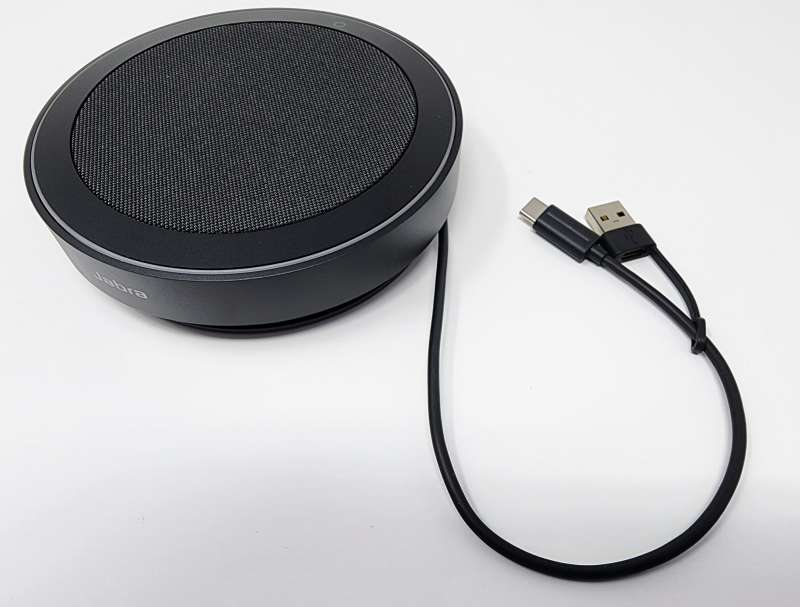
What’s in the box?
- The Jabra Speak2 75 device with a wired cable sporting both USB A and C connectors
- The Jabra Link 380 dongle to enable wireless connections to devices with a USB A port
- A felt carrying case including a slot for the 380 dongle
- A basic “getting started” card
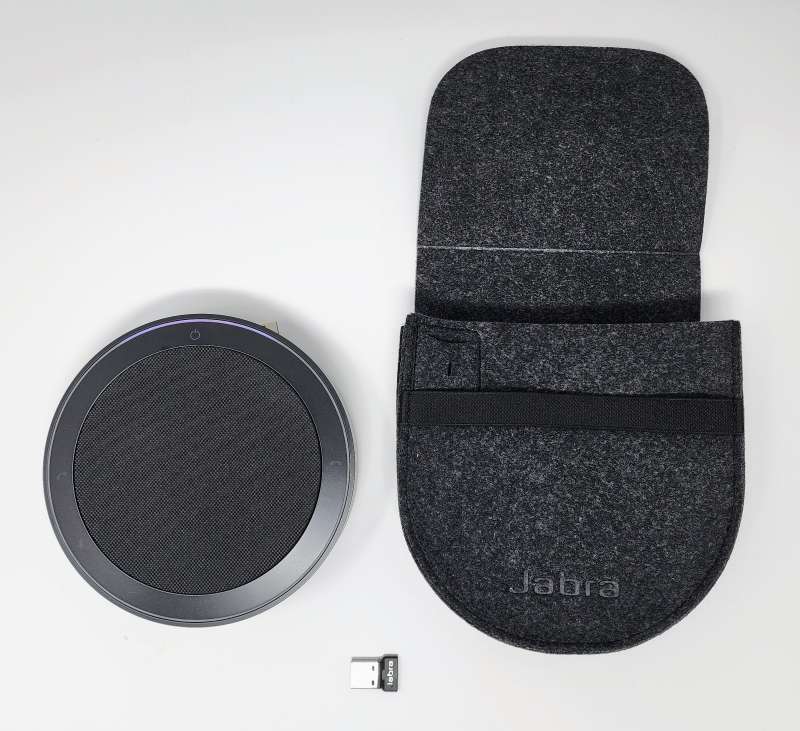
How does it work?
If you plan on using the Jabra Speak2 75 speakerphone wirelessly, your first step should be to charge the speakerphone. You can plug it into any power source that supports either a USB A or C connection. My review unit came with about 75% charge and plugging it into a standard USB A wall charger (a 100 watt charger which supports up to 22 watt charging via its USB A port), it took about 25 minutes to fully charge. Jabra claims that at 100% charge, the Speak2 will last about 32 hours on battery. In my testing – 12-15 hours of meetings plus streaming “music to code by” a few hours a day – I managed to get an entire week’s use before I had to recharge. Impressive.
While you are waiting for the Jabra Speak2 75 speakerphone to charge, download either the Jabra Sound+ app for your Android or iOS device. If you plan on using this with a computer, then download the Jabra Direct app from their website. On the computer, plug the 380 dongle into an available USB A port. The Jabra Direct app will help you keep both the Speak2 and 380 firmware up to date, plus both apps will open up a whole range of custom settings that’ll help you get the most from the speakerphone.
If you are using a computer and the 380 dongle, then there is nothing for you to do regarding connecting. Simply turn the Speak2 on and the 380 will automatically detect the speakerphone and make the connection for you. You can also plug the cable directly into any port on your computer to make the connection – although, if you do use it in wired mode, I would highly suggest you still plug in the 380 dongle as a backup. Twice during my testing a flaky USB hub disconnected all attached devices during a meeting, and the Speak2 seamlessly attached to the 380 and kept me on the call (although, to be fair, there was at least one occasion where I wish the Speak2 was not so reliable – giving me reason to bail out of a meeting that should have been a Teams message, not even an email).
I have the Jabra Speak2 75 speakerphone version that is specifically designed for Microsoft Teams (it still works great with Zoom, but more about why this is important below). Around the ring on top of the Speak2 are capacitive buttons which help manage the device:
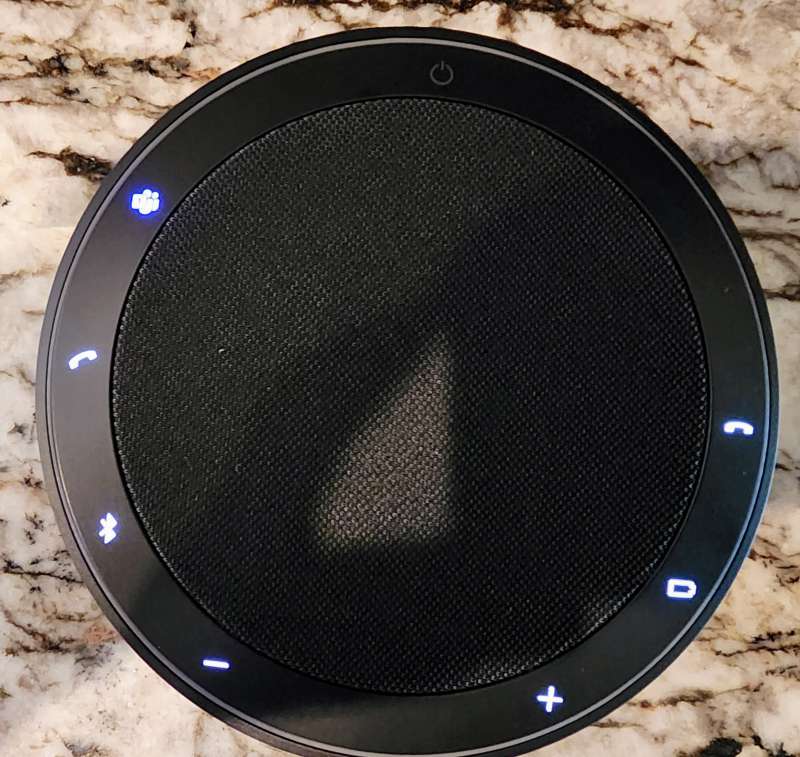
Going around from the top counterclockwise, you have the Power On/Off button (which, if you can’t figure out what that does, then you should sit quietly until the battery runs down) and a programmable button that by default is play/pause music (the button is not lit because I was not playing music).
The next button is the Microsoft Teams notification button. If a Teams meeting is starting or if you missed a call/received voicemail, this button flashes purple. Depending on the event that triggered the button, the Jabra Speak2 75 speakerphone will open Teams on the correct page (join a meeting, voicemail playback, missed calls, etc.). Honestly, this is a really handy feature to have if you live in Teams (for work) like I do. No more multiple-clicking in the app.
Continuing onward, the next button is the Answer Call button, followed by Bluetooth pairing (for non-380 wireless connections), Volume Down, Mute (only visible when in a call/meeting), Volume Up, Battery status, and the End or Reject Call button. Finally, around the outside of the button ring is a light which tells you the current microphone quality and status. In a call, the ring glows green if the Jabray Speak2 is picking up your voice clearly. Poor quality I think is supposed to be red, but it looks more like orange to me. Really handy to have – a couple of times I was looking at my monitors with the Speak2 slightly off to my right, and I could see out of the corner of my eye that the angle the speakerphone was picking up my voice was not great for the others on the call. Real-time feedback is important, especially if you are training others.
On an interesting side note, the Speak2 is also IP64 rated for protection against dust and water. There is now literally no reason I can’t take a meeting on the beach in Mexico. Or in my backyard during pollen season.
All in all, the sound quality of the Jabra Speak2 75 speakerphone in calls is outstanding. As long as I followed the mic quality guidance, I could be heard clearly – and, more importantly, background noise like dogs barking in the living room could not be heard. All meeting participants came through on my end loud and clear. The Speak2 has full duplex capabilities, so I could hear people ask questions while I was talking, and they could hear me when I made comments (all good ones – I never forget where the mute button is when I have less than complementary things to say).
I was highly skeptical that a speakerphone could also double as a decent music playback device, but I was pleasantly wrong about that assumption. The Speak2 has a rich, full sound and while it won’t be up to audiophile standards, it actually sounded better than the 2.1 system I had connected to my computer previously. It handily replaced the old speakers and saved me some desk space.
Previously, I had traveled for work, often spending 2-3 weeks away from home. My meeting companion for many a mile was the Jabra 710 UC, a predecessor of the Speak2. And in the interest of full disclosure, I have to say there were 2 things I liked about the 710 that are not present on the Speak2. Neither, however, have anything to do with the actual speakerphone function. First, the 710 had a handy dongle storage on the back of the speakerphone as well as a fold-out stand that allowed me to point the 710 directly at me. The Speak2 has neither – no stand, and a pocket on the felt case to hold the dongle.
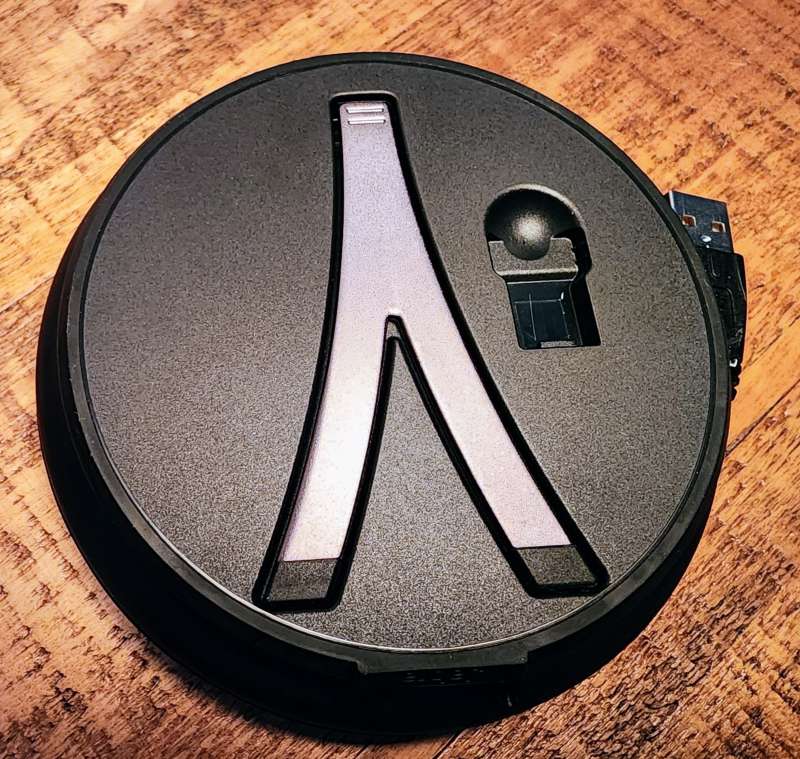
Here is the stand deployed:
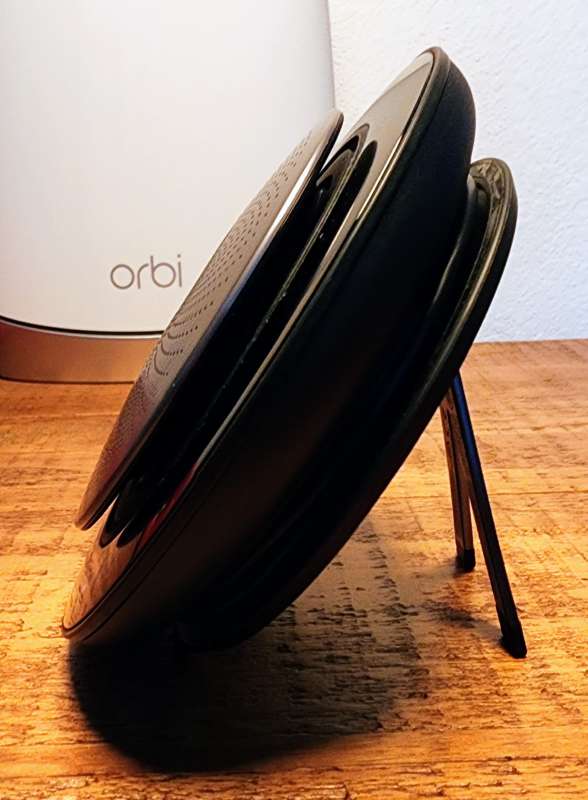
On the subject of the case, the 710 came with a very nice neoprene zipper case while the Jabra Speak2 75 speakerphone has a felt “pocket”. For such a high-end device, the case feels a little cheap. I wish Jabra would have stayed the course and kept that magnificent zipper case.
These are very minor complaints, however, when compared to the functional differences between the two speakerphones. I would take the Speak2 any day of the week over the 710.
What I like
- The sound quality is amazing and being full duplex, there are none of those awkward pauses during a meeting
- The integration with Microsoft Teams means less fumbling through menus and icons in the app
- The Speak2 is light yet rugged, and IP64 rated, making it an excellent traveling companion
What I’d change
- Add a vertical stand or other option to make the Speak2 more friendly to solo users
Final thoughts
My Jabra 710 has been a great speakerphone for many years now, but it has begun to show its age. When the opportunity came up to review the Jabra Speak2 75 speakerphone, I hoped the new version of the device would be at least as good as the previous generation. It wasn’t – it was an order of magnitude better. In the couple of weeks I have been using it, I have been blown away by both the sound quality and the integration with the communications tool I work with throughout the day. There is another version of the Speak2 which is designed for UC (Unified Communications), but that has more value for a conference room in a small to medium sized company. And the 380 dongle also comes in both a USB A or C version (and you can opt to not get a dongle at all if most of your meetings are through a tablet or phone), so there is pretty much a combination ready for anyone. While there is no tool that will make meetings interesting, the Jabra Speak2 75 speakerphone certainly makes them bearable. Unfortunately, the reliability of the Jabra Speak2 75 makes dodging meetings because your speakerphone wouldn’t connect to Teams a thing of the past.
Price: Depending on the configuration, starting at $369.00 and going to $389.00
Where to buy: Direct through Jabra and Amazon
Source: The sample for this review was supplied by Jabra.


